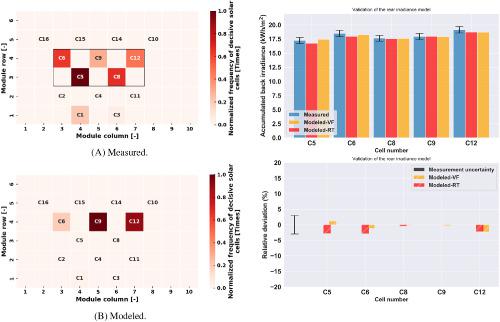当前位置:
X-MOL 学术
›
Prog. Photovoltaics
›
论文详情
Our official English website, www.x-mol.net, welcomes your
feedback! (Note: you will need to create a separate account there.)
A comparison of ray tracing and view factor simulations of locally resolved rear irradiance with the experimental values
Progress in Photovoltaics ( IF 8.0 ) Pub Date : 2020-03-11 , DOI: 10.1002/pip.3261 Djaber Berrian 1, 2 , Joris Libal 1, 3
Progress in Photovoltaics ( IF 8.0 ) Pub Date : 2020-03-11 , DOI: 10.1002/pip.3261 Djaber Berrian 1, 2 , Joris Libal 1, 3
Affiliation

|
One of the prerequisites for a reliable energy yield prediction of bifacial photovoltaic (PV) systems is the capability of modeling the backside irradiance of those systems with high accuracy. Currently, the most important optical models used to quantify the reflected irradiance on the backside of a bifacial solar panel are view factor and ray tracing. The MoBiDiG simulation tool has been developed at ISC Konstanz uses the view factor (VF) concept to model the rear irradiance. In addition to the VF concept, ray tracing (RT) has been adopted to determine the backside irradiance of bifacial modules by using the open‐source tool bifacial_radiance that has been developed by the National Renewable Energy Laboratory (NREL). A customized monocrystalline silicon solar panel has been built in order to evaluate the accuracy of the existing optical models by locally resolved rear irradiance measurement. The performance of rear irradiance has been investigated along the rows of the customized PV module during sunny and cloudy days with typical back irradiance values of  50 and
50 and  . The comparison of measured and modeled data has been carried out on hourly, daily, and monthly basis, and the results show lower deviations for solar cells located in the center of the PV module than on the edge. Moreover, the concept of decisive solar cells has been introduced and applied to both measured and modeled data, solar cells located in the center rows were found to act as the most decisive solar cells. Finally, considering the installation configuration studied here, ie, bifacial mounting with low clearance height (below 0.2 m), both hourly RT and VF approaches are able to model long‐term cumulative irradiance received by decisive solar cells with a very high accuracy ranging from
. The comparison of measured and modeled data has been carried out on hourly, daily, and monthly basis, and the results show lower deviations for solar cells located in the center of the PV module than on the edge. Moreover, the concept of decisive solar cells has been introduced and applied to both measured and modeled data, solar cells located in the center rows were found to act as the most decisive solar cells. Finally, considering the installation configuration studied here, ie, bifacial mounting with low clearance height (below 0.2 m), both hourly RT and VF approaches are able to model long‐term cumulative irradiance received by decisive solar cells with a very high accuracy ranging from  0.5% to
0.5% to  2%.
2%.
中文翻译:

局部解析后辐照度的射线追踪和视点模拟与实验值的比较
可靠地预测双面光伏(PV)系统的能量产量的先决条件之一是能够对这些系统的背面辐照度进行高精度建模。当前,用于量化双面太阳能电池板背面的反射辐照度的最重要的光学模型是视场因子和光线追踪。MoBiDiG仿真工具是由ISC康斯坦茨(ISC)开发的,它使用视角(VF)概念对后部辐照度进行建模。除了VF概念之外,还使用射线追踪(RT)通过使用国家可再生能源实验室(NREL)开发的开源工具bifacial_radiance确定双面模块的背面辐照度。定制的单晶硅太阳能电池板已经建成,以便通过局部解析后照度测量来评估现有光学模型的准确性。在晴天和阴天期间,沿着定制的PV模块行对后辐照性能进行了研究,典型的背辐值为 50和
50和 。每小时,每天和每月对测量数据和建模数据进行比较,结果表明,位于光伏组件中心的太阳能电池的偏差要小于边缘太阳能电池的偏差。此外,决定性太阳能电池的概念已被引入并应用于测量和建模数据,位于中间行的太阳能电池被认为是最具决定性的太阳能电池。最后,考虑到此处研究的安装配置,即低间隙高度(低于0.2 m)的双面安装,每小时的RT和VF方法都能够对决定性太阳能电池接收的长期累积辐照度进行建模,其精度非常高,从
。每小时,每天和每月对测量数据和建模数据进行比较,结果表明,位于光伏组件中心的太阳能电池的偏差要小于边缘太阳能电池的偏差。此外,决定性太阳能电池的概念已被引入并应用于测量和建模数据,位于中间行的太阳能电池被认为是最具决定性的太阳能电池。最后,考虑到此处研究的安装配置,即低间隙高度(低于0.2 m)的双面安装,每小时的RT和VF方法都能够对决定性太阳能电池接收的长期累积辐照度进行建模,其精度非常高,从 0.5%至
0.5%至 2%。
2%。
更新日期:2020-03-11
 50 and
50 and  . The comparison of measured and modeled data has been carried out on hourly, daily, and monthly basis, and the results show lower deviations for solar cells located in the center of the PV module than on the edge. Moreover, the concept of decisive solar cells has been introduced and applied to both measured and modeled data, solar cells located in the center rows were found to act as the most decisive solar cells. Finally, considering the installation configuration studied here, ie, bifacial mounting with low clearance height (below 0.2 m), both hourly RT and VF approaches are able to model long‐term cumulative irradiance received by decisive solar cells with a very high accuracy ranging from
. The comparison of measured and modeled data has been carried out on hourly, daily, and monthly basis, and the results show lower deviations for solar cells located in the center of the PV module than on the edge. Moreover, the concept of decisive solar cells has been introduced and applied to both measured and modeled data, solar cells located in the center rows were found to act as the most decisive solar cells. Finally, considering the installation configuration studied here, ie, bifacial mounting with low clearance height (below 0.2 m), both hourly RT and VF approaches are able to model long‐term cumulative irradiance received by decisive solar cells with a very high accuracy ranging from  0.5% to
0.5% to  2%.
2%.
中文翻译:

局部解析后辐照度的射线追踪和视点模拟与实验值的比较
可靠地预测双面光伏(PV)系统的能量产量的先决条件之一是能够对这些系统的背面辐照度进行高精度建模。当前,用于量化双面太阳能电池板背面的反射辐照度的最重要的光学模型是视场因子和光线追踪。MoBiDiG仿真工具是由ISC康斯坦茨(ISC)开发的,它使用视角(VF)概念对后部辐照度进行建模。除了VF概念之外,还使用射线追踪(RT)通过使用国家可再生能源实验室(NREL)开发的开源工具bifacial_radiance确定双面模块的背面辐照度。定制的单晶硅太阳能电池板已经建成,以便通过局部解析后照度测量来评估现有光学模型的准确性。在晴天和阴天期间,沿着定制的PV模块行对后辐照性能进行了研究,典型的背辐值为
 50和
50和 。每小时,每天和每月对测量数据和建模数据进行比较,结果表明,位于光伏组件中心的太阳能电池的偏差要小于边缘太阳能电池的偏差。此外,决定性太阳能电池的概念已被引入并应用于测量和建模数据,位于中间行的太阳能电池被认为是最具决定性的太阳能电池。最后,考虑到此处研究的安装配置,即低间隙高度(低于0.2 m)的双面安装,每小时的RT和VF方法都能够对决定性太阳能电池接收的长期累积辐照度进行建模,其精度非常高,从
。每小时,每天和每月对测量数据和建模数据进行比较,结果表明,位于光伏组件中心的太阳能电池的偏差要小于边缘太阳能电池的偏差。此外,决定性太阳能电池的概念已被引入并应用于测量和建模数据,位于中间行的太阳能电池被认为是最具决定性的太阳能电池。最后,考虑到此处研究的安装配置,即低间隙高度(低于0.2 m)的双面安装,每小时的RT和VF方法都能够对决定性太阳能电池接收的长期累积辐照度进行建模,其精度非常高,从 0.5%至
0.5%至 2%。
2%。











































 京公网安备 11010802027423号
京公网安备 11010802027423号